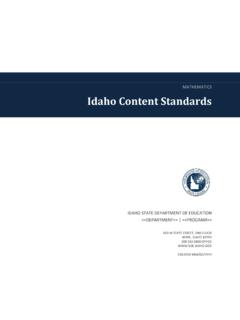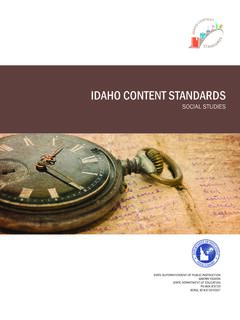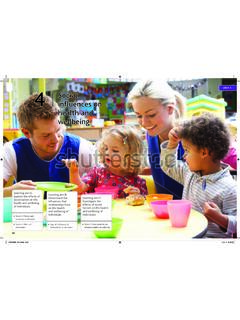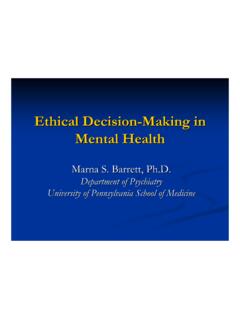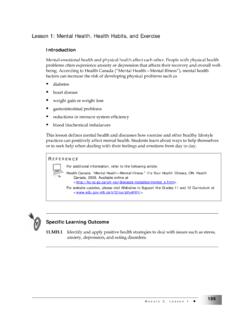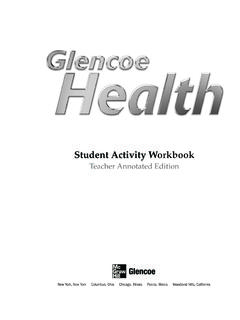Transcription of IDAHO CONTENT STANDARDS
1 IDAHO CONTENT STANDARDS . health EDUCATION. Kindergarten to Grade 2. Standard 1: Comprehend Core Concepts Core Concepts of health Education for K-Grade 2 are defined below: Alcohol, Tobacco, & Other Drugs The use of alcohol, tobacco, and other drugs has major implications in the lifelong health of individuals. Instruction includes the effects, influences, and prevention of the use of alcohol, tobacco products, and other types of drugs on the body and mind. Nutrition & Physical Activity To be ready to learn and to achieve their fullest potential, children need to be well nourished and physically active. In order to enhance physical, mental , emotional, and social wellness, students will acquire the knowledge and skills to make healthy food choices and engage in lifelong physical activity.
2 Injury Prevention & Safety Unintentional and intentional injuries rank among the greatest threats to the health of children. Instruction includes prevention through safe living skills and choices, violence prevention, and emergency response and preparedness. Understanding the consequences of one's decisions will help prevent injuries. mental , Emotional, & Social health mental , emotional, and social health are foundations for building wellness. Instruction includes a positive sense of self-image and self-esteem, recognizing emotions and socially appropriate responses of self and others. Prevention & Control of Disease Individuals have a considerable measure of control over their own health and the likelihood of contracting most illnesses. health -related choices and decisions regarding prevention of communicable and non-communicable diseases can include recognizing risk factors and identifying methods of contraction and transmission.
3 Consumer & Community health Children need to understand the different types of health care professionals and the benefit of health care services. Instruction includes how to identify trusted adults and professionals and how to access reliable product information. Growth, Development, & Family Life A healthy family is vital to the well-being and successful development of children and youth. Instruction includes the stages of life and changes in relationships with 1. others that accompany social development. Information should be factual, medically accurate, and objective. Environmental health Students need to be aware of the impact of environmental issues and hazards on personal health and the impact humans have on the environment. Instruction includes precautions and behaviors to safeguard personal health and practices that will reverse or slow down environmental pollution and related problems.
4 Goal : Students will comprehend core concepts related to health promotion and disease prevention to enhance health including: Alcohol, Tobacco and Other Drugs; Nutrition and Physical Activity, Injury Prevention and Safety; mental , Emotional, and Social health ; Prevention and Control of Disease; Consumer and Community health ; Growth, Development, and Family Life; and Environmental health . K-2nd Grade Objectives Objective(s): By the end of Second Grade, the student will be able to: Identify that healthy behaviors affect personal health . Recognize that there are multiple dimensions of health ( , emotional, mental , physical, and social). Describe ways to prevent communicable diseases. List ways to prevent common childhood injuries. Describe why it is important to seek health care.
5 Describe the impact of health behaviors on body systems. Standard 2: Analyzing Influences Goal : Students will analyze the influence of family, peers, culture, media, technology, and other factors on health behavior. K-2nd Grade Objectives Objective(s): By the end of Second Grade, the student will be able to: Identify how the family influences personal health practices and behaviors. Identify what the school can do to support personal health practices and behaviors. Describe how the media can influence health behaviors. Standard 3: Accessing Information Goal : Students will demonstrate the ability to access valid information, products, and services to enhance health . K-2nd Grade Objectives Objective(s): By the end of Second Grade, the student will be able to: Identify trusted adults and professionals who can help promote health .
6 Identify ways to locate school and community health helpers. 2. Standard 4: Interpersonal Communication Goal : Students will demonstrate the ability to use interpersonal communication skills to enhance health and avoid or reduce health risks. K-2nd Grade Objectives Objective(s): By the end of Second Grade, the student will be able to: Demonstrate healthy ways to express needs, wants, and feelings. Demonstrate listening skills to enhance health . Demonstrate ways to respond to an unwanted, threatening, or dangerous situation. Demonstrate ways to tell a trusted adult if threatened or harmed. Standard 5: Decision Making Goal : Students will demonstrate the ability to use decision-making skills to enhance health . K-2nd Grade Objectives Objective(s): By the end of Second Grade, the student will be able to: Identify situations when a health -related decision is needed.
7 Differentiate between situations when a health -related decision can be made individually or when assistance is needed. Standard 6: Goal Setting Goal : Students will demonstrate the ability to use goal-setting skills to enhance health . K-2nd Grade Objectives Objective(s): By the end of Second Grade, the student will be able to: Identify a short-term personal health goal and take action towards achieving the goal. Identify who can help when assistance is needed to achieve a personal health goal. Standard 7: Practice Healthy Behavior Goal : Students will demonstrate the ability to practice health -enhancing behaviors and avoid or reduce health risks. K-2nd Grade Objectives Objective(s): By the end of Second Grade, the student will be able to: Demonstrate healthy practices and behaviors to maintain or improve personal health ( , reducing spread of germs, encouraging healthy food behavior and physical activity).
8 Demonstrate behaviors that avoid or reduce health risks. 3. Standard 8: Advocacy Goal : Students will demonstrate the ability to advocate for personal, family, and community health . K-2nd Grade Objectives Objective(s): By the end of Second Grade, the student will be able to: Make requests to promote personal health . Encourage peers and family to make positive health choices. 4. IDAHO CONTENT STANDARDS . health EDUCATION. Grades 3-5. Standard 1: Comprehend Core Concepts Core Concepts of health Education for Grades 3-5 are defined below: Alcohol, Tobacco, & Other Drugs The use of alcohol, tobacco, and other drugs has major implications in the lifelong health of individuals. Instruction includes the effects, influences, environmental exposure, prevention and treatment of the use of alcohol, tobacco products, and other types of drugs on the body and mind.
9 Nutrition & Physical Activity To learn and to achieve their fullest potential, children need to be well nourished and physically active. In order to enhance physical, mental , emotional, and social wellness, students will acquire the knowledge and skills to make healthy food choices and engage in lifelong physical activity. Injury Prevention & Safety Unintentional and intentional injuries rank among the greatest threats to the health of youth. Instruction includes prevention through safe living skills and choices, violence prevention, and emergency response and preparedness. Understanding of the consequences of one's decisions will help prevent many injuries. mental , Emotional, & Social health mental , emotional and social health are foundations for building wellness.
10 Instruction includes a positive sense of self-image and self-esteem, recognizing emotions and socially appropriate responses to self and others. Prevention & Control of Disease Individuals have a considerable measure of control over their own health and the likelihood of contracting most illnesses. health -related choices and decisions regarding prevention of communicable and non-communicable diseases can include recognizing risk factors and identifying methods of contraction and transmission to include universal precautions. Information should be factual, medically accurate, and objective. Consumer & Community health Youth need to understand how health care services are provided as well as how individuals can take an active role in determining the use of health related services and products.


